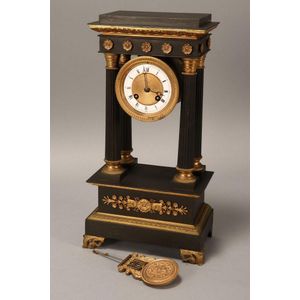French Empire Style Mantle Clock, 1900
Early 20th century French Empire style mantle clock, marked to rear movement Medaille D'or Samuel Marti, Paris 1900, in patinated bronze and gilt, the circular white enamel dial with Roman numerals surrounding an inner gilt engine turned centre, set between four ormolu mounted and fluted classical columns, the whole raised on a rectangular plinth base with central foliate themed plaque, with circular foliate medallion pendulum, a/f (missing glass cover), 41 cm x 22 cm x 12.5 cm
You must be a subscriber, and be logged in to view price and dealer details.
Subscribe Now to view actual auction price for this item
When you subscribe, you have the option of setting the currency in which to display prices to $Au, $US, $NZ or Stg.
This item has been sold, and the description, image and price are for reference purposes only.
- Bronze - An alloy of copper and tin, traditionally in the proportions of about 9 parts of copper to 1 part of tin.
The discovery of bronze in Western Asia in the 4th century enabled people to create metal objects which were superior to those previoulsy possible because of its strength and hardness, and it has been used throughout the world for weapons, coins, tools, statuary and other decorative items.
It is very fluid in a molten state, and its hardness, strength when set, and non-corrosive properties makes it most suitable for casting sculpture. - Ormolu - Ormolu was popular with French craftsmen in the 18th and 19th century for ornamental fittings for furniture, clocks and other decorative items. True ormolu is gilt bronze, that is bronze that has been coated with gold using a mercury amalgam. Due to the health risks associated with using mercury, this method of creating ormolu was discontinued in France in the 1830s. A substitute was developed consisting of about 75% copper and 25% zinc, however it was inferior to the bronze version. It was often lacquered to prevent it tarnishing.
- A/f, as Inspected - The letters "A/F" or "as inspected" as part of a description is the cataloguer's shorthand for "all faults" or "as found", meaning the item has some type of damage or deficiency, it is of uncertain date or provenance, and/or that the seller takes no responsibility for the completeness of the item or the accuracy of the description.
- Engine Turned - Engine turning is a decorative technique used on metal surfaces to create intricate curving or geometric pattern. The process involves cutting a series of lines into the surface of the metal using a rose engine or decoration lathe which rotates the metal as it cuts, allowing the operator to create a repeating pattern that covers the entire surface. The resulting surface has a shimmering, reflective quality that is often described as "engine turned." Where an engine turned item has been enamelled, the term used to describe the decoration is usually guilloche.
Engine turning was originally developed to decorate metal objects such as firearms, scientific instruments, and other metal objects that required precise and elegant design. - Movement - The technical name for the workings of a clock or watch, and does not include the dial or case.
- Foliate - Decorated with leaves or leaf-like forms.
- Empire Style - The Empire style was a version of neo-classicism popular from 1800 to 1830, coinciding with the rule of Napoleon I from 1840-15. In England the style corrosponds with the Regency style and in the United States to the Federal style.
The style is inspired by classical Rome and Greece, as reflected in the decorative motifs in the the design such as paterae, guilloches, acanthus and swags, and pieces are lavishly decorated with applied gilded decoration. - Pendulum - The pendulum was discovered around 1602 by Galileo Galilei, and was adopted for time keeping by the Dutch mathematician and natural philosopher, Christiaan Huygens, who excelled in astronomy, physics, and horology.
The pendulum comprises a metal rod usually of brass or steel with a metal disk, known as a bob, at the end. The movement of the pendulum is driven by weights or a spring, and as a pendulum swings in a regular arc, it was found accuracy could be controlled to within a few seconds a week.
Timekeeping can be adjusted by changing the height of the bob on the rod, making the pendulum either swing slower or faster.
The disadvantage of the pendulum was that changes in temperature also changed the length of the pendulum, interfering with the accuracy of the clock, and so in the 18th century two types of mercurial pendulums were invented which countered the movement in the steel rod.
The pendulum was the world's most accurate timekeeping technology until the invention of the quartz clock, regulated by a quartz crystal, in 1927.
This item has been included into following indexes:
